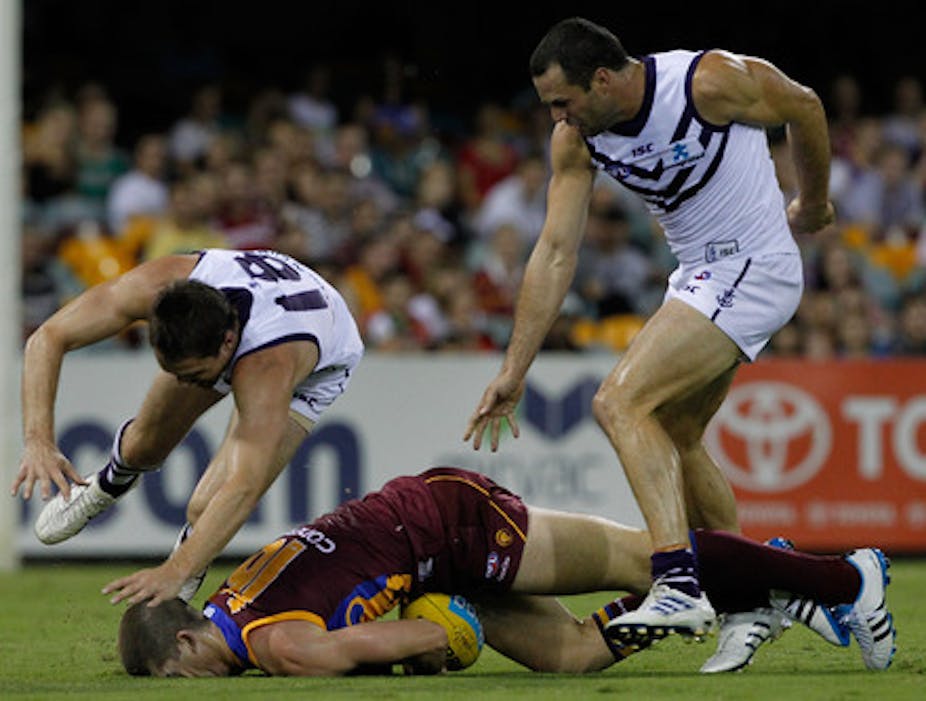The intense public interest in protective headgear following recent cases of high-profile AFL players sustaining concussion and other head or face injuries, is understandable.
Unfortunately we have limited knowledge of the effectiveness of helmets because so little research on the question has been conducted. Neither is there a great deal of information on the long-term effects of sport-related concussion.
But some evidence is now emerging that the cumulative effects of repeated concussions may increase the likelihood of cognitive impairment later in life.
A recent US study shows that retired professional American gridiron players with a history of repeated concussions are five times more likely to develop mild cognitive impairment compared with retirees without a history of concussion.
The same researchers also reported that retired players with a history of repeated concussion were three times more likely to be diagnosed with clinical depression compared with retired players without a history of concussion.
Only a small percentage of athletes with a history of repeat concussion appear to suffer long-term problems and identifying those athletes at future risk of neurological impairment is currently not possible.
So can helmets reduce the concussion rate in Australian footballers? Laboratory studies carried out at in the School of Sport and Exercise Science at Victoria University tested the shock absorbing ability of a range of “padded” helmets that could be used in the various football codes.
For sports like Australian Rules football, the helmet can’t have a hard outer shell because it would then pose a potential impact hazard to other players. The testing involved an artificial head with internal sensors that measured the shock absorption of the helmets during drop-tests simulating the impact energy likely to produce a concussion.
It was found that only one of the seven helmets tested was likely to reduce the risk of head injury and this helmet had the thickest padding and foam density.
Based on the laboratory results, most padded helmets were not thick enough or firm enough to significantly reduce injury risk, but one was adequate. This result was promising but laboratory-based findings provide low-level evidence as to the effectiveness in actually reducing the sport injury rate.
What we need is research conducted on the field with players in league games along with laboratory testing of new helmets.
This high-level evidence is not available because there have been no controlled, long-term studies comparing the injury rates of football players wearing helmets with those not wearing helmets.
A recent study on the effectiveness of padded helmets in young rugby players concluded that the helmets did not reduce the rate of head injury or concussion but the compliance rate was low – there is a reluctance to voluntarily wear protective headgear.
This is one of the major obstacles to conducting prospective studies into the effectiveness of non-mandatory protective equipment.
A group of researchers attempted to evaluate the effectiveness of helmets on community junior and senior football players but found that most of the players allocated to wear the helmets did not end up doing so. It was concluded that given the low level of support for helmets, other strategies for injury prevention needed to be explored.
There are a number of reasons why footballers resist wearing a helmet: it isn’t mandatory, cost, discomfort, weight, bulk, aesthetics, impeding temperature regulation, vision or hearing, or it may become “target” for the opposition players.
Another concern with helmets is the notion of “risk compensation” - where footballers engage in more dangerous activities because of the belief that protective equipment may make them more invincible, in effect potentially increasing their risk of injury.
Protecting one body part might increase the risk of injury to another. The small number of football players that choose to or have been “advised” to wear helmets temporarily have usually sustained a previous head injury and seem to wear the helmet during training more so than match-games.
Basically, we don’t know if helmets can reduce head injuries in football because the appropriate long-term comparative studies haven’t been conducted.
Sporting organisations may be reluctant to fund such a project – it might be perceived as an admission that the sport is hazardous and discourage participation.
Anecdotal evidence suggests some parents prefer their children play soccer rather than football because it is believed to be safer. It could be argued that the concussion rate is low in football and recent rule changes protecting head contact will reduce the likelihood of head injuries.
The latest available AFL injury data indicated that the concussion rate at the elite level was about one newly concussed player per team every two seasons, but this figure may be misleading because a concussion was only recorded if it caused a player to miss a future match.
We need to fund research into all these areas in our efforts to minimise head injuries and the long-term effects of concussion.
Other stories on this topic:

